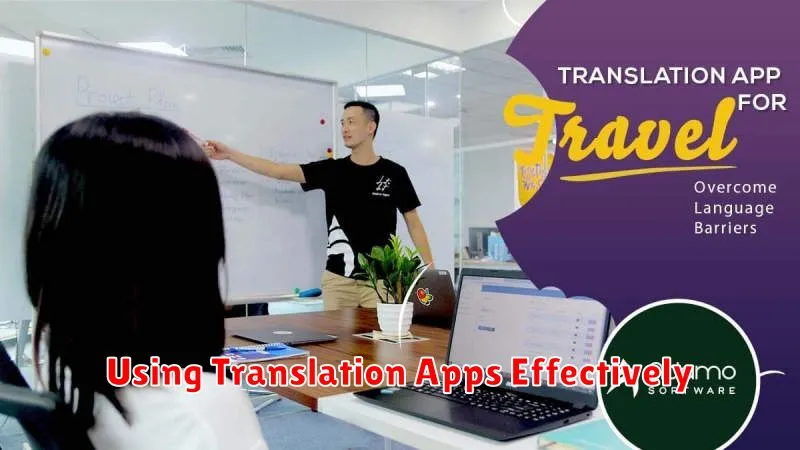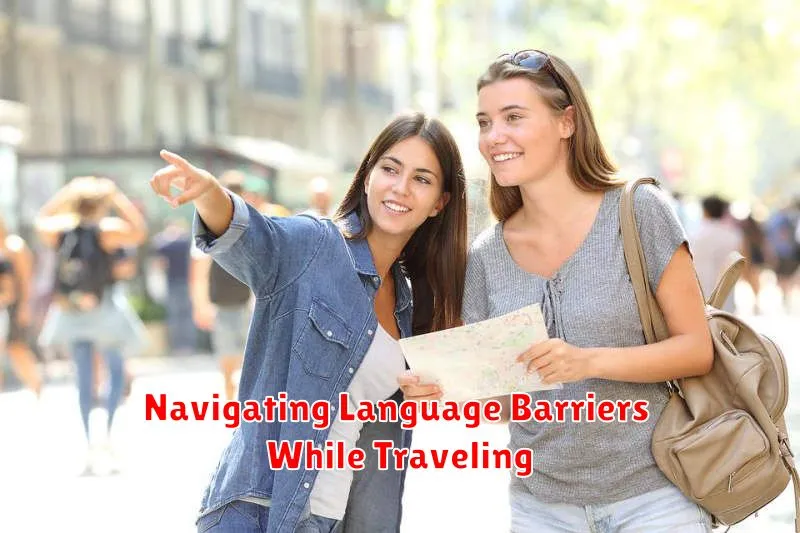Traveling to new and exciting destinations can be an incredibly enriching experience. However, language barriers can often present challenges for travelers, potentially hindering their ability to fully immerse themselves in the local culture, navigate unfamiliar surroundings, and connect with people from different backgrounds. This article explores practical strategies and invaluable resources for navigating language barriers while traveling, empowering you to confidently embark on your adventures and overcome communication obstacles with grace and ease. Whether you’re a seasoned globetrotter or preparing for your first international trip, understanding how to bridge the communication gap is essential for a truly memorable and meaningful travel experience.
From pre-trip planning to in-the-moment communication tactics, we’ll delve into essential tips for overcoming language barriers and fostering meaningful connections with locals. Discover the power of basic phrases, explore the benefits of translation apps and language learning resources, and learn how to effectively utilize nonverbal communication to enhance your interactions. We’ll also address common anxieties associated with language barriers while traveling and provide practical advice for managing miscommunication with sensitivity and respect. By equipping yourself with the right tools and strategies, you can transform potential linguistic challenges into opportunities for growth, understanding, and deeper cultural immersion. So, prepare to unlock the true potential of your travels and embark on a journey of seamless communication and global connection.
Why Language Preparation Matters
Effective communication is crucial in today’s interconnected world. Whether for academic pursuits, professional endeavors, or personal travel, adequate language preparation can significantly impact your success and overall experience. It allows you to connect with people from different cultures on a deeper level, fostering understanding and building meaningful relationships. Lack of preparation can lead to miscommunication, frustration, and missed opportunities.
Investing time in language learning demonstrates respect for the local culture and a willingness to engage with the community. Being able to understand and speak the language, even at a basic level, can greatly enhance your ability to navigate new environments, access information, and participate fully in local activities. This can lead to a richer, more immersive experience and a greater appreciation for the nuances of the culture.
Beyond the practical benefits, language preparation offers cognitive advantages. Studies have shown that learning a new language can improve memory, problem-solving skills, and overall cognitive flexibility. It can also boost your confidence and open doors to new personal and professional opportunities.
Learning Key Phrases Before You Go
Traveling to a new country can be an exciting, yet daunting experience, especially if you don’t speak the local language. Learning a few key phrases before you go can significantly enhance your trip, making it easier to navigate, connect with locals, and handle everyday situations. Prioritizing essential phrases like “hello,” “goodbye,” “please,” and “thank you” demonstrates respect and facilitates positive interactions. Beyond basic greetings, focusing on phrases related to transportation, dining, and asking for directions can greatly improve your travel experience. This simple preparation can transform a potentially stressful situation into a smoother, more enjoyable one.
While mastering the entire language isn’t necessary for a short trip, learning phrases related to common travel scenarios can be incredibly helpful. For example, knowing how to ask “Where is the bathroom?” or “How much does this cost?” can prevent misunderstandings and frustration. Consider creating a small phrasebook or using a language-learning app to practice these essential phrases before you depart. Even a basic understanding of the local language can make a world of difference in your ability to navigate and enjoy your travels.
Beyond practical considerations, the effort to learn even a few phrases in the local language can show respect for the local culture and foster positive connections with the people you meet. Locals often appreciate the effort, even if your pronunciation isn’t perfect. This small gesture can lead to more enriching and authentic travel experiences, going beyond the typical tourist interactions. Don’t be afraid to try! Embracing the challenge of communication can transform your trip into a truly memorable adventure.
Using Translation Apps Effectively

Translation apps offer a convenient way to bridge language barriers, but using them effectively requires understanding their limitations. While they excel at providing quick translations of individual words and simple phrases, they often struggle with nuances, idioms, and complex sentence structures. Therefore, it’s crucial to avoid relying on them for critical translations, such as legal or medical documents, where accuracy is paramount.
To maximize their usefulness, focus on using translation apps for basic communication, such as asking for directions, ordering food, or understanding simple signs. Proofread the output carefully, and be prepared to rephrase your input if the translation seems awkward or nonsensical. Context is key; providing additional information can help the app generate a more accurate translation. Consider using multiple apps and comparing their results for increased confidence.
Remember that translation apps are tools, not replacements for human understanding. They are best used to facilitate communication, not to achieve perfect fluency. By understanding their strengths and weaknesses, you can leverage these apps effectively to enhance your travel experiences, learn new languages, and connect with people from different cultures.
Gestures and Visual Aids to Communicate
Effective communication relies not only on spoken words but also on non-verbal cues like gestures and visual aids. Gestures, such as hand movements and facial expressions, can emphasize points, convey emotion, and help regulate the flow of conversation. Used thoughtfully, they enhance understanding and engagement. However, it’s crucial to be mindful of cultural differences in gesture interpretation to avoid miscommunication. Visual aids, including charts, diagrams, and presentations, provide a visual representation of information, making complex ideas more accessible and memorable. Choosing the appropriate visual aid depends on the context and the specific information being conveyed.
When incorporating gestures, remember to keep them natural and purposeful. Avoid excessive or distracting movements that might detract from your message. Practice using gestures that feel comfortable and reinforce your spoken words. For visual aids, clarity and simplicity are key. Ensure visuals are easy to read and understand, avoiding cluttered designs or overwhelming amounts of information. Focus on highlighting the most important data and using visuals that support, not overshadow, your spoken message.
Combining gestures and visual aids strategically can significantly improve communication effectiveness. A well-placed gesture can draw attention to a key point on a slide, while a concise chart can clarify a complex concept explained verbally. By integrating these elements thoughtfully, you can create a more engaging and impactful presentation, ensuring your message is understood and remembered by your audience.
Dealing with Misunderstandings Politely
Misunderstandings are a common part of communication. When they occur, it’s crucial to address them with politeness and respect. Begin by actively listening to the other person’s perspective without interrupting. Try to understand their point of view, even if you don’t agree with it. Ask clarifying questions to ensure you grasp their meaning and express your own thoughts calmly and clearly. Using phrases like “I understand you feel…” or “From my perspective…” can help facilitate a productive conversation.
If the misunderstanding stems from your actions, take responsibility and apologize sincerely. Even if you didn’t intend to cause offense, acknowledging the impact of your words or actions can go a long way in resolving the issue. Focus on finding a solution that works for both parties, and be willing to compromise. Remember, maintaining a respectful and positive tone is essential, even when discussing difficult topics.
Finally, after the conversation, take some time to reflect on what happened. Consider what you learned from the experience and how you might prevent similar misunderstandings in the future. Effective communication involves not just speaking clearly but also actively listening and seeking to understand others. By approaching misunderstandings with empathy and a willingness to learn, you can build stronger relationships and avoid unnecessary conflict.
Avoiding Sensitive Topics Without Context
Navigating conversations without inadvertently touching on sensitive topics can be challenging when context is lacking. Understanding your audience is crucial. Without background information, assumptions about their experiences, beliefs, and values can lead to unintentional offense. Avoid generalizations and broad statements about potentially controversial subjects such as politics, religion, personal relationships, or finances. Instead, focus on neutral and universally relatable topics like current events (weather, sports), hobbies, or shared experiences.
Active listening is key. Pay attention to verbal and nonverbal cues. If someone seems uncomfortable or hesitant, gently steer the conversation in a different direction. Be mindful of your own language and avoid using jargon, slang, or humor that could be misinterpreted or culturally insensitive. When in doubt, err on the side of caution and choose safer conversational ground. Asking open-ended, non-intrusive questions can help you gauge the other person’s comfort level and guide the discussion appropriately.
If a sensitive topic arises unexpectedly, acknowledge the situation with grace and respect. A simple, “I apologize, I didn’t mean to bring up a potentially uncomfortable subject,” can go a long way. Then, redirect the conversation to a less sensitive area. Remember, respectful communication involves being mindful of others’ perspectives and prioritizing a positive and inclusive environment.
Making New Friends Despite Language Gaps
Connecting with people from different linguistic backgrounds can feel daunting, but language barriers shouldn’t prevent you from forming meaningful friendships. Nonverbal communication plays a crucial role. A smile, a nod, and genuine interest conveyed through body language can transcend words. Shared activities, like playing sports or engaging in hobbies, provide opportunities to bond over shared experiences rather than complex conversations. Even simple gestures, like offering help or sharing a meal, can foster a sense of connection and build a foundation for friendship.
While verbal communication may be limited, leveraging technology can bridge the gap. Translation apps can facilitate basic conversations and demonstrate your willingness to understand their language. Learning a few key phrases, such as greetings and simple questions, shows respect and can go a long way in building rapport. Don’t be afraid to use gestures, drawings, or even charades to communicate ideas. Embrace the humor in miscommunications – laughter is a universal language that can connect people from all walks of life.
Ultimately, building friendships across language differences relies on patience and empathy. Focus on building trust and showing genuine interest in the other person’s culture and experiences. Celebrate the differences and view them as opportunities to learn and grow. With a little effort and an open mind, you can forge strong and lasting friendships that enrich your life, regardless of language.

